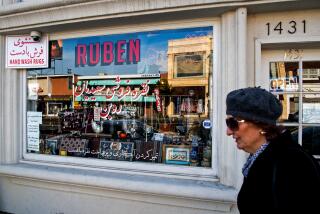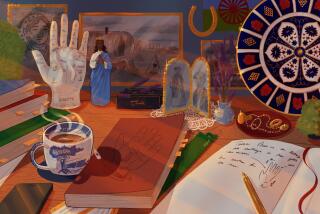Zoroastrian Faith Celebrates New Year
- Share via
In solemn ceremonies featuring pungent sandalwood incense and hot coals, flowers and plates of fresh fruit, Southern California’s Zoroastrian community is celebrating its new year this week.
Azrir Bhandara, 37, a Zoroastrian priest, welcomed a dozen of the faithful to his Irvine home, where he set out a white sheet on which he and the others, many dressed in white to symbolize purity, knelt in prayer.
Before beginning, Bhandara covered his mouth with a white scarf. “When you pray,” he said, “there is a possibility of spray coming out of your lips, but it shouldn’t get into the sacred fire.”
The new year for Zoroastrianism, one of the world’s oldest monotheistic religions, begins Aug. 21. According to one ancient calendar, today is the birthday of the Persian prophet Zarathustra, founder of the faith. To honor him, adherents from across Southern California will gather this afternoon at the California Zoroastrian Center in Westminster.
The believers are part of Southern California’s growing Iranian population. Worldwide, Zoroastrians number about 200,000, scholars estimate, with about 15,000 of those in North America.
“It’s not a very strict religion,” said Richard H. Dekmejian, political science professor at USC and a scholar of comparative religions in the Persian empire. “It’s very intellectual, and in many ways it has a rationality of its own. It’s very peace-loving and respectful of nature.”
Among well-known Zoroastrians is Indian-born Zubin Mehta, former conductor of the Los Angeles and New York philharmonic orchestras who was appointed in 1998 as music director of the Bavarian State Opera in Munich.
The religion was founded in 1500 B.C. by Zarathustra, whose name in Greek is Zoroaster. He wrote the Gatha, a collection of hymns contained in the Avesta; and a book of scripture in which he advocated a love of nature and taught disciples to focus on good deeds, good words and good thoughts. The faithful find the pathway to heaven through seven principles: wisdom, righteousness, moral strength, love, perfection, immortality and the holy spirit.
At one time Zoroastrianism was the dominant faith of the Persian empire. Today its adherents are concentrated in India and Iran, scholars say. India has the largest community, about 100,000. Iran has about 60,000.
When the Arabs conquered Iran in 625, Zoroastrians were forced to renounce their religion and follow Islam. Since then they, like other minority cultures and faiths through history, have had to balance the tenets of their beliefs with assimilation into mainstream culture, Dekmejian said.
“Minorities tend to intermarry and try to defend themselves against acculturation, and that keeps them very encapsulated,” he said. “There has been quite a bit of cultural erosion. But they do uphold the Persian customs. Zoroastrians represent the civilization of ancient Persia.”
Following an influx of Iranian immigrants to the United States in the early 1980s, California became a center for Zoroastrianism, Dekmejian said. Temples like the one in Westminster have been built all along the coast.
Whether in sanctuaries or homes, prayer sessions are rich with symbols: The presence of God is represented by fire; water stands for perfection, milk for wisdom, flowers for immortality.
“God is the manifestation of energy,” said Rohinton Bamboat, 62, of Costa Mesa, among the worshipers Wednesday at Bhandara’s home. “In all our ceremonies we use fire. That is the dance of God.”
After age 7, each member wears a simple white cotton vest under his or her clothing and wraps a solid-colored lambs wool tie around the waist three times to represent goodness of deed, word and thought.
Emphasis on the environment is a key element of the faith, as is a view of all believers as one family.
Sam Billimoria, 56, of Irvine, who grew up as a Zoroastrian in his native Bombay, India, said he considers Southern California’s community of believers to be his home.
“Ecology is a big part of our religion,” Billimoria said. “But there are still so many controversies for such a small community like us.”
One of those is that the priesthood does not include women, who among the more orthodox are excluded from prayer groups when they are menstruating.
Segregation by gender does not alienate Zoroastrian women such as Parvin Bamboat, 63, and Dhun Alamshaw, 54, both of Costa Mesa.
“It doesn’t offend us,” Bamboat said, wrapping a white scarf around her head before carrying fresh fruit into the living room at Bhandara’s home. “We’ve just been brought up that way.”
A Zoroastrian New Year celebration and prayers will be at 4:30 p.m. today at the California Zoroastrian Center, 8952 Hazard Ave., Westminster. For admission costs and other information, call (714) 893-4737.
More to Read
Sign up for Essential California
The most important California stories and recommendations in your inbox every morning.
You may occasionally receive promotional content from the Los Angeles Times.













